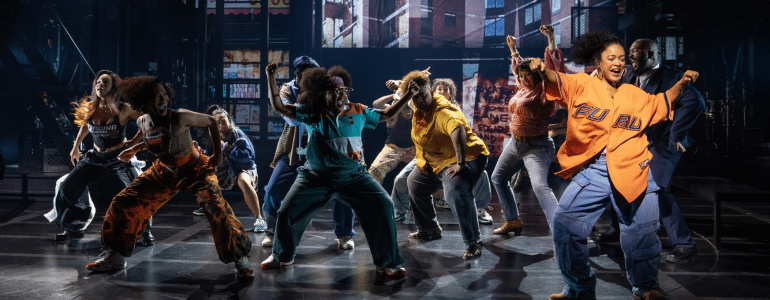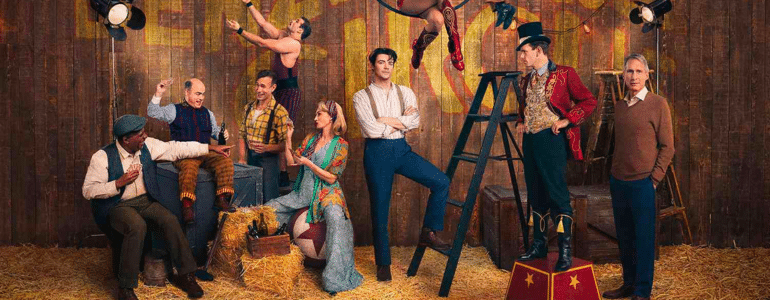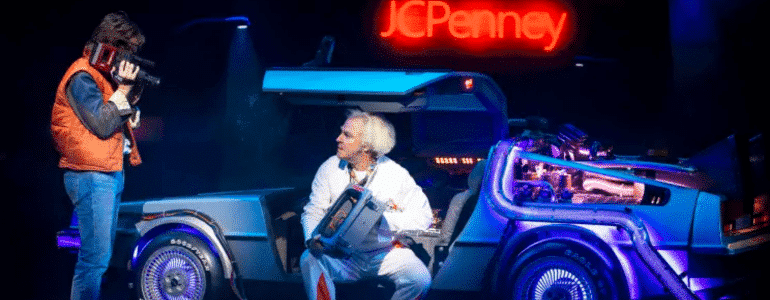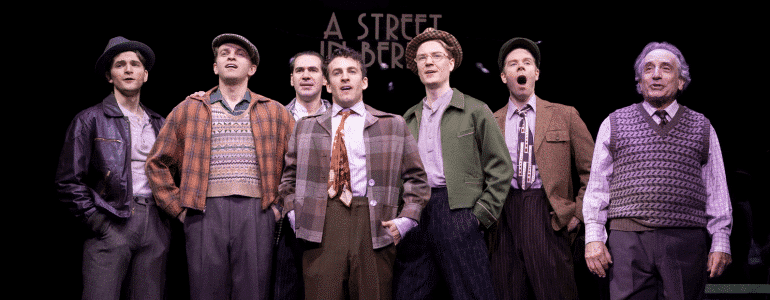Episode 5 Transcript – Drew Hodges
Ken: Hello everybody, this is Ken Davenport. Welcome back to The Producer’s Perspective Podcast, episode number five. Thanks to everyone for listening and for your e-mails. Keep them coming, especially if you want to hear from specific folks or certain types of professions in our industry. Let me know and we will make it happen. Today is actually an example of that. I’ve had so many requests from all of you to speak to advertising and marketing experts and today I’m sitting right across the table from the authority on the subject of advertising and marketing Broadway shows. I’m very fortunate to be picking the brain of Drew Hodges, the founder of one of the industry’s leading advertising agencies, SpotCo. Welcome, Drew.
Drew: Thank you very much.
Ken: To list SpotCo and Drew’s clients would take about 354 podcasts so I’ll just name a few, going back to the beginnings, which we’ll talk about. Chicago, Rent, Kinky Boots, Gentleman’s Guide, The Last Ship and so on, it’s really just boring to list them all so instead I’ll give you this statistic to give you an idea of the type of guy and the company we’re talking about. SpotCo has originated the art for 10 of the last 20 Best Musicals in the past 20 years, including every winner since 2008.
Drew: The last seven in a row for best musical.
Ken: It’s amazing. Amazing. So that’s my first question, Drew. You and your company really define how Broadway looks and communicates to the rest of the world. How did you end up in the position that you are now?
Drew: Well my history was I was doing entertainment design, so I did records, I did movies, I did cable channels, back when we were inventing cable channels, like I worked on the launch of Comedy Central and The Daily Show and I did albums for Aerosmith and Lisa Loeb. So that’s what I did, I did entertainment. Then I did some film stuff, oddly enough, and I had a small design studio – there were five of us – and Geffen hired David, hired us, to do Rent. That was the first thing that we did. I understand he did it because he wanted to sell albums in the front of the record store where rock and roll albums were stacked and not the back of the record store where show tune albums were stacked. I literally heard that quote. I actually just confirmed this recently, that in fact David had no connection to the show other than the album. So we were really brought in to design the record but we had a strong marketing background and I went and saw the show and met with the producers, Jeffrey Seller and Kevin McCollum, and gave them my point of view as to how I would do it and it just turned out to fit really with how they thought they were going to do the show and I wrote the copy myself, I did the graphics myself. The easiest thing to market is to yourself. Most of the time none of us get to market to ourselves but at the very beginning I was very lucky that the first project I worked on I was really using myself as the audience member and I had a real point of view about what I called the “lapsed Catholics” of Broadway which was myself, people who had gone to Broadway for a very long time and had really enjoyed Broadway. But I always felt like the materials that were put out there didn’t connect to me, they didn’t look like other stuff in other entertainment worlds that I knew so I never felt that they were an invitation to me. So really, what we did with Rent and what we had done for a long time, was we looked at all the kinds of people that we were working with in other entertainment vehicles – film, records, music videos – and brought those artists to bear on Broadway and that gave a much more contemporary flavor to the work that we did.
Ken: Were you a theater fan before all of this?
Drew: I grew up in Hyde Park, Rhinebeck area, and took the train down. I was the kid who would, Monday morning, get the Arts and Leisure in the high school library and go through the concerts and the shows and plan the trips and buy the tickets and go with my friends to the city. A little more rock and roll than Broadway, but I was still a Broadway fan, and then I went to art school here in the city, at the School of Visual Arts, so I had been here for four years. Well, by the time I did this work I had been here for seven years, by the time I did Rent. So I had actor friends, I was very aware of shows and would go regularly. I wasn’t an avid but actually that was an asset. I didn’t go all the time, I didn’t know everything there was to know, I was really a true consumer so I had the sense of what it was like for me to look at these ads and to choose to buy a ticket and the problems I had and that was a great asset. It’s really great when you don’t know what you don’t know.
Ken: Obviously Rent was how many years ago now? We’re getting close to 20 years now. Obviously the world has changed a lot in 20 years, certainly Broadway has changed a lot. What do you think has changed the most about the advertising and marketing over the last 20 years?
Drew: Well certainly media is more expensive. We’ve moved from a print world to a digital broadcast and outdoor world, so I would say you have to be much more aware now of things moving and I still find that everybody, including me, can fall into the trap of going, “What’s the poster? What’s the poster?” It’s not really about the poster that much. It certainly is about the brand, just as it was then, and I always thought that it’s really about the personality that you put out there. I’m a big fan of this idea of the emotional promise that you’re giving an emotional promise to a buyer. You’re saying, “I promise you, if you buy a ticket to this, the evening will feel like this. It’s not what’s going to happen, not who’s in it, not what the plot points are, but what I’m going to leave you with.” So the more emotional you can make the work, the more powerfully effective it is. That’s the same now as it was then but I would say that things move more and because there are so many more pieces – you used to do a full page ad in the New York Times and that would be your campaign – now that you make so many elements it’s just so much stronger a concern that they go together. It’s very easy to have your digital ads be a little different than your print ads be a little different than your TV and it’s very easy to have your campaign fracture, so I would say with more executional elements at this point you just have to be that much more aware of what your strategy is and stay with it, because it’s really easy to wander. Whereas in the old days producers would just get a whim to run a headline this week different than last week and now it’s obviously not so easy to just kind of wing it because all of it needs to go together.
Ken: The emotional promise – I love that concept – when you’re originally coming up with the idea for art, what is your process? How do you start with a blank page or a blank sheet to where we’re going to go with this art?
Drew: I had this passion – this happened four or five years ago. It came from a producer. Margo Lion said to me, about a show that ultimately struggled, about Catch Me, she said, “I’m worried what the event is,” and I said, “Tell me about that,” and she said, “Literally what is the reason you go? What’s the event?” And I became fascinated by that word and I now use that a lot and internally, we talk about what the event will be. The event is not the elevator speech, the event is the, “Why go?” If your neighbor says to you, “What should I see?” – I’m assuming anybody listening to this has a neighbor who asks them what they should see – then you say something, “Gentleman’s Guide,” and then the next thing they say is, “Why?” Every time they say, “Why?” What you say next is the event. It can be very simple. The event can be Hugh Jackman, the event can be the story of Houdini, the event can be circus meets Pippin. The event can be very clean and clear and those are the easiest ones to sell. But the event can also be the emotional promise. The other thing I want to say that we’ve learned is, that if you don’t define your event it will be defined for you. There’s no question that it will, and usually in a direction you don’t want. With Kinky Boots I was terrified that the event was going to be “the next drag queen musical,” that that’s what someone would say. “What should I see?,” and you’d say “Kinky Boots,” and they’d say, “Why?” and you’d say, “It’s got these guys and these legs and these boots,” and I thought, “That’s what’s going to happen. That’s what this show is going to be,” so we decided to make the event Chicago reviews and then we didn’t get such great reviews in Chicago but the score did and Cyndi did so then we decided absolutely, emphatically to make the event Cyndi and, coming into New York, all the quotes were about Cyndi, Cyndi, Cyndi, because when somebody says to you, “What should I see?” “Kinky Boots.” “Why?” You can literally say, “Cyndi Lauper,” and people go, “Oh! That’s why.” “Unique point of sale” is a phrase you hear a lot in advertising and marketing. This is my version of that, but it’s a little more emotional than just a unique thing, it’s the emotional “why?” There’s always any number of events. Just by definition, on any show, you can think of five or six reasons why someone might go. Four of them might be really bad reasons but they’re reasons. It’s a revival, it’s new, it’s at a theater I like, it’s directed by someone who’s interesting. So there are often reasons. Your job is to figure out which one is the one that actually turns the key. We’ve had shows where we knew what the event was but we knew that telling someone that ahead of time was going to be nearly impossible. An example of that is when Avenue Q went to Vegas. In Vegas it’s supposed to be an event for it to be there. You’re supposed to know the brand, people are in Vegas, there are statistics that say they’re there for two and a half days so they walk into town knowing what it is, and they say, “Oh yeah, Cher. Cher is Cher, I’ll go to Cher.” Avenue Q had no profile, even though it had won the Tony. I think it was amazing that they thought that it did, the “they” here being Steve Wynn. Steve Wynn thought, “It won the Tony, everyone will come,” and we knew no one would go, so we actually ended up covering taxi cabs in orange fur because one of the things we found out was that, in Vegas, a lot of your information comes from taxi drivers, so we thought if we could get the taxi drivers in to see the show and if we could get a consumer in the back seat to ask the driver, “What’s that about? Why the hell is your cab covered in orange fur?” then we could get the event to happen, which is, “Oh, it’s so funny. It’s so satirical. You’ve never seen anything about it.” In that case we knew that the event wasn’t something that we could necessarily communicate upfront. So sometimes you have to pick the event and then look strategically to see which of these events you can actually communicate early versus later. Obviously without great reviews from Chicago we couldn’t really communicate the event being reviews for Kinky Boots, but we could do Cyndi. Then, once we got them, after Cyndi we made the event basically, “You’re flying on air when you leave the theater,” then we made the event the Tony Awards, then we made the event huge box office wraps, and now we’ve been going back for Cyndi because we’ve got a newer audience, we’ve got a tourist audience that’s coming in and we have to kind of redefine the event for them because you always have to keep doing it if you’re lucky enough to have a show running for a while.
Ken: Is there any example of a show that you feel you got the event, you cracked it, this is fantastic, maybe it’s the orange fur with Avenue Q, and then the people just don’t come or the show just doesn’t work?
Drew: Many, many. The obvious one is Seussical. I thought that the ad campaign was great, David LaChapelle, funky, funny, and the show just didn’t work. Now it’s done everywhere. It’s incredibly successful on the community theater circuit. Everyone has their theory why the show didn’t work; I thought the campaign was great. Liz McCann told me no hit show has a bad ad campaign, meaning once the show succeeds that artwork is inherently knighted as beautiful and the opposite is also true. When a show doesn’t work, the campaign sucks, whether it actually does or not. I have many others that I loved but didn’t work.
Ken: I’m certainly at fault for this because when my shows have not worked in the past one of the first things I think everyone says is, “We’ve got to change the advertising. We’ve got to change the marketing.” How do you deal with people calling you and banging on conference tables – and now there are many people around those tables – saying it’s the art when it isn’t? Can the art really make the difference? Can the advertising make the difference or, at the end of the day, is it that show and that theater and that experience that these people are sharing?
Drew: Well that’s two questions. I’ll take the first one. Honestly, I wish I could say that there’s a way to deal with it but mainly, really you need to know that people need to change it because they are mostly in that place and even though you know it may not really help you actually usually end up changing it because it’s just too difficult for people to see it any other way. It’s one of the things they can control. When someone says, “Whatever we’re doing now certainly isn’t working,” that’s such a difficult thing to argue with and that may not be the reason, but usually you end up changing. On the other hand, can it change it? I have to say a huge turnaround has not happened through advertising unless that advertising is advertising something actually new. So you can recast. Annie Get Your Gun can pick up Reba or Fantasia can go into The Color Purple and you can have a whole new day. You can put the two together, you can have advertising that meets with something really concrete, usually casting, and get something good to happen. In really doing a huge pot of money to turn something around, Rocky would be an example. I do know, and I didn’t do it, that some of the key people on Rocky had done the Mary Poppins campaign and considered that an example of $1 million spent to turn around audience perception. So if you know what the problem is and the problem is something you can actually change, you can sometimes change the way a show is perceived. But I will say that, in the end, what advertising does is take a small amount of success and make it larger. What it doesn’t do is invent success. It’s taken me a lot of years to say that to people but if isn’t there, you can’t make it. If it’s there, you can try to enlarge it, so the game is usually, “Who’s loving it?” Who’s into theater? It’s groups, it’s church groups, it’s African Americans, it’s kids, it’s parents bringing kids, it’s older people. Every show finds a group that’s really particularly loving it. There’s always a pragmatic discussion as to whether there’s enough of those people around but advertising can help you enlarge it – it’s like a drop of water and ripples going out, but the ripples have to already be there for us to amplify them. You don’t invent them, you enlarge them.
Ken: You obviously work with an enormous number of producers, all sorts of different types. I won’t ask you to name your favorite or least favorite . . . maybe when we shut it off . . . but what are some of the characteristics that you see in the more successful producers or the ones that you think are the real leaders of the industry and doing great things?
Drew: I want to say something really specific here. There are two different kinds of successful producers. Everyone believes that they are David Merrick. Everyone believes that they have just a feeling, but very few are, very few are. There are a few who actually can just feel it and they are great leaders in that. But you can be just as successful knowing that you are not David Merrick. That doesn’t mean that you’re not any good at it, it just means that you’re not a savant, that you need to think about these things, and those people can be just as successful by using research, by really exploring and considering. So there are two different types of people that we work with. Many, many people could be more successful if they just were self-accepting that maybe they’re not David Merrick, but that doesn’t make them bad producers. It only makes you a bad producer when you’re unwilling to confront that fact. It’s a rare skill that you’re just able to feel your way in to what your show should be or what your advertising should be. The best ones by far are playful, the best ones are trusting – and that doesn’t mean blind trusting – people who delegate well, people who say, “This is your part, this is my part.” I have producers who will say to me, “That’s my part. I’ll go back and give you something to sell,” but then it’s my job to sell it well and they know that. But the poor ones mix it up all the time and they think it’s my fault that the message isn’t resonating. It’s really hard to answer this question and not dive into specifics right now. I have a show right now on Broadway where the whole show takes place in a place, and that place is named in the title, and the producers have decided the reason the show isn’t working is that place. But everything about the show is that place. That’s very difficult, to decide that the core of your show isn’t working. You can’t be who you’re not, you can’t trick people. There’s no faster way to shut a show down. Back to that emotional promise – you have to deliver on the emotional promise. You can’t promise people big laughs and deliver chuckles, you’ll be closed in three weeks. I did a show once, Dance of the Vampires, that we all thought was going to be Michael Crawford making his romantic return to Broadway, and we sold it that way. We had a letter from Michael, “Please come and see me,” Jim Steinman, big in Germany, very symphonic music and then we got there and it was like a pie in the face, it was like Benny Hill, and we were shocked, we had no idea that the show was going to be that. And the audiences were furious, they were furious. They came to see Michael Crawford singing a romantic ballad and they got Michael Crawford as Benny Hill and they felt that they had been duped. So it has to be something that you’re genuinely going to deliver on, and then you promise that and the art of it is communicating that so that it feels less like something dry and more like something emotional.
Ken: You mentioned the “R” word in one of your last answers – research. This is something that’s very close to my heart, as you know, but something that’s really come into its own over the last decade or two in other industries and it seems to be just gaining steam here. Are you a pro research person, anti-research, where do you stand?
Drew: I’m a huge pro-research person although I have to say, I wish I could tell you that I’ve seen it be a magic bullet ever, like beginning, end and all. I don’t have the case study to say, “Here it is people. If you do the research this way . . .” I really want one. What I don’t like so much is focus groups where the art gets tested, blah, blah, blah. You can pretty much tell people ahead of time what’s going to happen and it’s fine that that goes on and that that happens and perhaps you’ve done some of that work but what I really find much more interesting is trying to test for the bigger ideas – what is it about my idea, what’s your supposition before you know anything, what’s your supposition knowing a little and what is the little that changes the supposition? Because you can take any show’s idea and say, “It’s about this,” and then rate it on a scale and then say, “What if I add this and this?” You’re trying to find the thing that flips it because, again, in my emotional promise or my event, let’s say there are five or six things. You really want to know what’s the powerful one. “I thought it was going to be about Jersey, I thought it was going to be about my leading lady’s difficulties, I thought that was going to be the hook that really flips it.” Let me give you an example. On the research on The Color Purple we did all of this very un-filmic artwork and then one – one – campaign, which is the one that you ended up seeing, with the girls pat-a-caking in the field, which is literally lifted directly from the Spielberg movie. That doesn’t happen in the book, it doesn’t happen in the musical. And we did the focus groups and, to that audience, which was primarily African American, the movie is a classic and for once they didn’t mind at all that it had been a movie and they couldn’t understand why we were moving away from the movie. The movie was what they wanted, it’s what they came for onstage, and so the pat-a-cake went in, it went in right away, they didn’t really want us to move it to some kind of fresh new folksy art, they wanted the movie. Usually it’s the opposite. I feel like in most of the research we do people are telling you, “Yeah, I like the idea of that. It’s based on that movie I liked,” but nowadays everybody wants to know, “Why should I not just stay at home and watch this on TNT?” It just comes up over and over again so you have to tell people why this is unique, why it’s different this time, why it’s got to be live.
Ken: How do you deal with the very few advertising agencies there are in this business, because I don’t think the business can support any more? You obviously have a lot of competitors in the same conference room. How do you deal with those kind of conflicts when you have several shows that are all campaigning for the same Tony Award?
Drew: Well you don’t have competitors in the same conference room.
Ken: Well not at the same time.
Drew: At the same agency?
Ken: Yes, exactly.
Drew: Well this is a conversation everyone loves to have with me and I’m really straightforward about it. We’ve had many years when we’ve had all four in a category, and I’m a big believer in campaigning for a Tony and I think our record speaks for itself that you can, in fact, effect this, but the way that you effect it is not by, again, mounting some kind of superfluous campaign. You have to really know exactly who you are and this time we have to add in the element of competitors, you have to know who they are and who you are. I find it really helps when I know how I’m going to delineate each of these shows in their own way, because if I don’t know then I don’t know what’s coming. That probably seems odd but often I can tell. This comes from the days when we did cable channels. You would work on Comedy Central and you would work on Nickelodeon and you would work on Cartoon Network and you had to understand each brand really well, like, “What is the brand? What’s it about? What is this?” Heading into any Tony race, you don’t know until they open but you get a real sense that this is what this show is going to be – this is the art show, this is the crowd pleaser show, this is the British show. In any year you have to really know what your show is in context to the others and then you push that campaign out. I don’t try to just do that. Everything I’ve said here is absolutely true but the shorter answer is, I don’t do the one, I take the whole pie and I split it up, including shows we don’t have, and I try to do a unique selling point and a strategy point on every show I think could be nominated and then figure out what we need to be, and it changes. Once, when it began, the event was authenticity. When we were downtown we wanted to be real, we wanted to be Rent, we wanted to not seem like some made-for-Broadway experience because we thought it was kind of the un-musical. So we do that, that works, Ben changes his mind, unbelievably, when we open on Broadway, and we become sort of the un-musical for Broadway, but when we headed to the Tony awards, suddenly that’s a negative, or I decided that I thought that was a negative, that we were the small show and people gave us no chance. In these seven years of winning, there’s quite a few years in there where the horse we had in it was not considered at all, starting with Avenue Q, being the first one, because supposedly it didn’t have a chance. With Once, we decided that, actually, we needed to suddenly become big, so we did double trucks and we knew we would have the numbers and the same thing happened with Gentleman’s Guide – we had done the math and we knew they were likely to get the greatest number of nominations by nature of how many things were eligible in how many categories. It wasn’t a guess, it was that they were available to be nominated in that many categories, so we knew that a logical strength for them was that it was going to be the most nominated show. But that’s only because we also did the math for every other show and we knew where it could tie, and we had that campaign ready to go. I don’t know if you remember but that campaign launched the night the last show opened. That was unusual and kind of bold but I think it helped them win.
Ken: Our last question – the question that I ask to everyone – imagine that the fairy godmother, Drew’s fairy godmother from Cinderella, which you advertised, comes down and says, “Drew, I’m going to grant you one wish. With a wave of my magic wand you can change anything you want about Broadway, but just one thing.” Anything that’s been bugging you over the last couple of decades you can change just with one wave. What would that one thing be?
Drew: Instead of giving the emotional answer, which is that everyone should be nicer, the answer is that I would like to see opening nights used as a marketing asset rather than a party. That will mean, for me, I’d love to see opening nights simulcast live across the country and with sponsors like Sears to tell you that Cinderella – which almost happened on Cinderella and everybody tried very hard to make it happen and another company, much like Sears, was actually ready to do it and sponsor Cinderella across the country with stations in girls’ clothing sections that said, “Win a ticket to opening night.” It all makes perfect sense if you think it out, that you use your opening night. I don’t think many people would see it. People would see the advertising for it and then they would learn, nationally, that there was a show called Cinderella opening in New York. As it is, it takes us a year or more to get a national presence for a show. I think opening nights should be used as a national marketing platform to tell people that you’ve arrived.
Ken: I love that idea. I’m sure a ton of producers are mad at me for stealing Drew away from working on their shows right now so I’m going to let him get back to work. Thanks so much for being here, Drew, and thank all of you for listening to episode 5, which is now in the books, so to speak. Next up is episode 6 and this is going to be a fun one – I’m super excited because we’re going to sit down with the guy that Broadway loves to hate, Broadway gossip columnist for the New York Post, Michael Riedel, so subscribe now, the next episode will be up Monday at 11. See you then!
Podcasting
Ken created one of the first Broadway podcasts, recording over 250 episodes over 7 years. It features interviews with A-listers in the theater about how they “made it”, including 2 Pulitzer Prize Winners, 7 Academy Award Winners and 76 Tony Award winners. Notable guests include Pasek & Paul, Kenny Leon, Lynn Ahrens and more.













